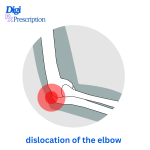
Elbow dislocation is a serious injury that can cause significant pain and limit arm function.Understanding how elbow dislocation happens, its symptoms, and how to treat it is key to getting back to full mobility and strength.
In this post, we'll break down the causes, symptoms, treatment options, and recovery for elbow dislocations.
What Is an Elbow Dislocation?
An elbow dislocation happens when the bones of the elbow joint are displaced, either partially or completely, from their normal alignment. This is a painful injury and often occurs as a result of a direct blow or a fall, especially when the arm is extended.
There are two main types of elbow dislocations:
-
Anterior Dislocation – when the forearm is displaced in front of the upper arm (more common).
-
Posterior Dislocation – when the forearm moves behind the upper arm (less common but more severe).
⚠️ Causes of Elbow Dislocation
Elbow dislocations are often caused by trauma or accidents, such as:
-
Falls – falling on an outstretched arm is the most common cause.
-
Sports Injuries – especially in contact sports like football, rugby, or basketball.
-
Car Accidents – where the arm is bent in an unnatural position during impact.
-
Repetitive stress – in rare cases, repeated pressure or force on the joint can lead to dislocation.
The symptoms of an elbow dislocation are usually immediate and severe. Common signs include:
-
Intense pain at the elbow joint.
-
Deformity – the elbow may appear visibly out of alignment.
-
Limited or no range of motion – the arm may be unable to bend or straighten.
-
Bruising – in some cases, bruising around the elbow may develop.
-
Numbness or tingling – if nerves are affected by the dislocation.
Medical intervention is required immediately after an elbow dislocation to prevent long-term damage to the bones, ligaments, and nerves.
✅ Immediate Steps:
-
Immobilize the arm: If you suspect a dislocation, keep the arm still and avoid trying to move it.
-
Apply ice to reduce swelling and manage pain (but do not apply ice directly to the skin).
-
Seek emergency care: Go to the hospital immediately. Elbow dislocations require professional medical attention.
✅ Reduction (Realignment of the Elbow):
-
In the hospital, a healthcare professional will perform a reduction (realigning the bones).
-
Sedation or anesthesia is usually required to relieve pain and ensure the joint is properly manipulated back into place.
✅ Post-Reduction Care:
-
Splinting or casting may be used to keep the elbow in place as it heals.
-
Pain management: Over-the-counter or prescribed pain medications may be given.
-
Physical therapy: After the joint has healed, physical therapy will help restore strength, flexibility, and range of motion.
Recovery from an elbow dislocation generally involves the following stages:
-
Rest: After the joint is reduced, rest is crucial to prevent re-injury.
-
Immobilization: The elbow may need to be immobilized with a splint or cast for several weeks.
-
Rehabilitation: Once the initial healing has occurred, physical therapy will help restore full functionality.
-
Gradual Return to Activity: It’s important to avoid strenuous activity until the elbow is fully healed to prevent complications.
⚡ Complications of Elbow Dislocation
While most people recover well from an elbow dislocation, some may face complications, including:
-
Chronic instability: If ligaments were stretched or torn during the dislocation.
-
Nerve damage: The ulnar nerve or other nerves around the elbow can be affected, leading to long-term numbness or weakness.
-
Arthritis: Repeated dislocations or severe trauma can increase the risk of developing arthritis in the joint.
With proper care, most people recover fully, but it’s essential to follow treatment plans and allow the joint to heal completely. If you experience an elbow dislocation, don't hesitate to seek medical help to avoid permanent damage and ensure the best recovery outcomes.
References
-
American Academy of Orthopaedic Surgeons (AAOS) – Elbow Injuries
https://orthoinfo.aaos.org/en/diseases--conditions/elbow-injuries/ -
Cleveland Clinic – Elbow Dislocation Overview
https://my.clevelandclinic.org/health/diseases/21782-elbow-injuries -
Mayo Clinic – Elbow Dislocation Treatment
https://www.mayoclinic.org/diseases-conditions/elbow-dislocation/ -
Johns Hopkins Medicine – Elbow Injuries and Treatment
https://www.hopkinsmedicine.org/health/conditions-and-diseases/elbow-injuries -
StatPearls – Elbow Dislocation
https://www.ncbi.nlm.nih.gov/books/NBK538349/
